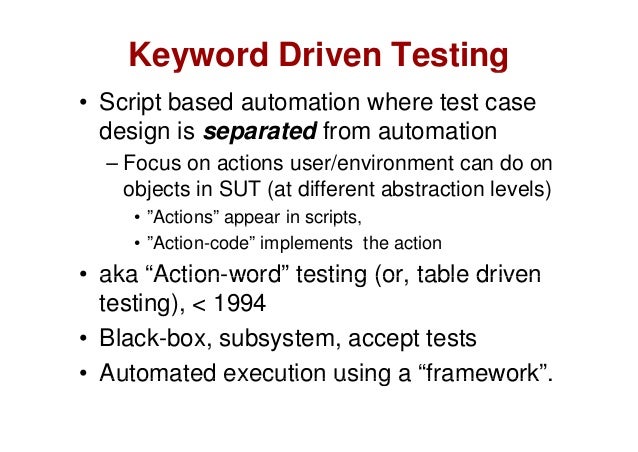Introduction
The rapid improvement of artificial intelligence (AI) has directed to the introduction of sophisticated code generators that promise to revolutionise software development. These types of AI-powered tools can easily automatically generate computer code snippets, entire capabilities, or even finish applications based in high-level specifications. However, ensuring the high quality in addition to reliability of AI-generated code poses substantial challenges, particularly when it comes to key-driven testing. This content explores the principal difficulties associated with key-driven testing for AJE code generators and even presents potential solutions to address these issues.
Understanding Key-Driven Assessment
Key-driven testing is a methodology in which test cases are generated and performed based on predefined keys or guidelines. In the circumstance of AI program code generators, key-driven testing involves creating the set of inputs (keys) that are used to assess typically the output of the generated code. The goal is to ensure that the AI-generated code complies with the desired practical and performance criteria.
Problems in Key-Driven Tests for AI Signal Generators
Variability in AI Output
Concern: AI code generator, particularly those structured on machine understanding, can produce various outputs for the same input because of to the inherent probabilistic nature associated with these models. This variability helps it be difficult to create steady and repeatable test out cases.
Solution: Carry out a robust established of diverse analyze cases and inputs that cover a variety of scenarios. Use statistical methods to evaluate the variability throughout outputs and make sure that the developed code meets the specified criteria across diverse outputs. Employ techniques such as regression testing to observe and manage adjustments in the AI-generated code over moment.
Complexity of AI-Generated Code
Challenge: The particular code generated by AI systems may be complex and may even not always comply with guidelines or standard coding conventions. This complexity can make it difficult in order to manually review plus test the code effectively.
Solution: Make use of automated code evaluation tools to examine the quality and adherence to coding standards of the AI-generated code. Integrate static code evaluation, linters, and code quality metrics directly into the testing canal. This helps inside identifying potential concerns early and helps to ensure that the generated code is maintainable in addition to efficient.
Lack of Understanding of AI Designs
Challenge: Testers may well not understand fully the particular AI models employed for code generation, which can hinder their ability to be able to design effective test cases and translate results accurately.
Solution: Enhance collaboration between AI developers plus testers. Provide teaching and documentation upon the underlying AJE models and their expected behavior. Create a deep knowing of how distinct inputs impact the generated code as well as how to translate the results regarding key-driven tests.
Energetic Nature of AJE Models
Challenge: AJE models are frequently updated and refined as time passes, which can easily lead to changes in the generated code’s conduct. This dynamic characteristics can complicate the testing process and require continuous adjustments to try cases.
Solution: Implement continuous integration plus continuous testing (CI/CT) practices to retain the testing process lined up with changes inside the AI types. Regularly update test cases and inputs to reflect the latest model updates. check this site out to manage distinct versions of the generated code plus test results.
Difficulty in Defining Important Parameters
Challenge: Determining and defining suitable key parameters intended for testing can end up being challenging, especially if the AI code generator produces intricate or unexpected results.
Solution: Work tightly with domain experts to identify pertinent key parameters plus develop a complete pair of test cases. Use exploratory assessment processes to uncover border cases and uncommon behaviors. Leverage comments from real-world employ cases to refine and enhance the particular key parameters utilized in testing.
Scalability of Testing Initiatives
Challenge: As AI code generators produce more code in addition to handle larger jobs, scaling the tests efforts to include all possible scenarios becomes increasingly tough.
Solution: Adopt test out automation frameworks and tools that can take care of large-scale testing efficiently. Use test case management systems to organize and prioritize test out scenarios. Implement seite an seite testing and cloud-based testing solutions to be able to manage the improved testing workload effectively.
Best Practices for Key-Driven Testing
Define Clear Objectives: Establish obvious objectives and standards for key-driven screening to make certain the AI-generated code meets the desired functional and even performance standards.
Design and style Comprehensive Test Cases: Develop a various group of test situations that concentrate in making a large range of scenarios, including edge situations and boundary problems. Ensure that the test out cases are consultant of real-world work with cases.
Leverage Motorisation: Utilize automation equipment and frameworks in order to streamline the screening process and deal with large-scale testing successfully. Automated testing can easily help in handling the complexity and even variability of AI-generated code.
Continuous Development: Continuously refine and improve the key-driven testing process depending on feedback and results. Adapt test situations and methodologies to maintain changes in AI models and program code generation techniques.
Create Collaboration: Encourage effort between AI designers, testers, and site experts to make sure a thorough knowledge of the AI versions and effective style of test cases.
Bottom line
Key-driven testing for AI code generator presents a unique pair of challenges, coming from handling variability in outputs to taking care of the complexity of generated code. By simply implementing the remedies and best methods outlined on this page, organizations can improve the usefulness of their screening efforts and guarantee the reliability plus quality of AI-generated code. As AJE technology continues in order to evolve, adapting in addition to refining testing strategies will be vital in maintaining high standards of computer software development and delivery.

